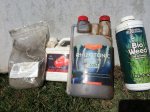I was hoping to see if I could get some feedback on tested methods for rehabilitation when a tree is showing signs of struggling in the spring when it should be pushing. I have a collected Doug Fir with a number of the branches that have died over the winter. It was wintered in a greenhouse above 32F. It seems like there is at least a couple branches with color still in the needles and buds, so I think there is still some hope. It is warm here now (Chicago) and all of the other trees are pushing, but I haven't seen anything happen in this Fir.
I'm wondering if folks have any methods they have used to gently encourage struggling trees through the spring. It has been recommended to me to take sphagnum moss and soak it in a mixture of superthrive and rooting hormone and pile that around the top of the soil and keep it moist. All of this is to be done while keeping the tree sheltered from much light to slow down any growing process to try and not let the tree use up too many nutrients that it has left. So for this I am keeping it in a garage with one window.
Does anyone have information that they think this would be bad? Any other techniques to get trees to come back?
I'm wondering if folks have any methods they have used to gently encourage struggling trees through the spring. It has been recommended to me to take sphagnum moss and soak it in a mixture of superthrive and rooting hormone and pile that around the top of the soil and keep it moist. All of this is to be done while keeping the tree sheltered from much light to slow down any growing process to try and not let the tree use up too many nutrients that it has left. So for this I am keeping it in a garage with one window.
Does anyone have information that they think this would be bad? Any other techniques to get trees to come back?


